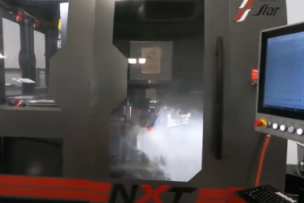So says John Smalley, MSC’s Senior Director of Solutions Strategy and Innovation, and Field Solutions Director Chad G. Himmelman. Both would obviously like to provide VMI solutions to your shop. Yet both will also tell you that setting the choice of VMI partner and system aside, what’s most important is for shops to gain a clear understanding of the benefits and pitfalls of this supply chain initiative—and do so before jumping into the VMI pool.
Here are some of the questions a typical manufacturing company might have when evaluating the benefits and challenges of VMI, along with answers from these two experts in supply chain management:
Q: Why do companies use VMI?
A: Vendor managed inventory programs shift the cost and responsibility of managing key consumables and nuisance items to a trusted partner. They also consolidate spend to a single supplier, automate the procure-to-pay process and reduce labor cost for receiving and put away. That said, the customer always retains control over what items are included in the agreement, as well as how often and how much is replenished. The end result is greater efficiency, and the elimination of stockouts, obsolescence and waste.
Read more: Cobots and Manufacturing: 3 Ways Collaborative Automation Can Help Your Shop
Q: How does vendor managed inventory work?
A: That depends on the agreement and the customer’s needs. Vendor managed inventory might be just as its name describes: an automated, nearly hands-off approach that frees the manufacturer of the burden and expense associated with tool crib and supply management. But it can also be more manual in nature, with the end user micromanaging scanning, purchase order approval and demand planning.
Q: What kinds of facilities is it best suited for?
A: All manufacturers can benefit from having a vendor managed inventory program, provided that it has been tailored to their procurement process and commodity needs. A job shop, for example, might choose to leverage VMI through a vending machine for their perishable tooling needs, while assembly firms and batch manufacturers could use a bin-stock program for low-cost supply items and the like. Either way, such a program simplifies the supply chain while reducing the risk and labor costs associated with traditional tool crib management.
Q: What kinds of parts and tooling are a good fit for VMI?
A: Simply put, practically any consumable item is a VMI candidate. There are traditional bin-stock programs available for items like fasteners, fittings, batteries and safety supplies. Cribware or bar code scanners can be used to manage storeroom supplies, such as janitorial and facility maintenance products. And vending machines are often placed close to production cells and contain critical metalworking consumables and—more recently—personal protective equipment.
Read more: Avoiding Unplanned Downtime: 3 Ways Technology Can Help
Q: Can you offer any quantifiable benefits or success stories?
A: “We’re not at liberty to discuss individual customer’s success stories except to say that the benefits of a well-run VMI program affect all areas of a manufacturing facility,” says Smalley. “The procurement team enjoys a reduction in consumption rates and an increase in usage visibility. Operational cost savings are realized throughout the procure-to-pay process via electronic purchase order placement. There’s also labor reduction due to the elimination of cycle counting and manual replenishment, together with higher inventory turns resulting in increased cash flow.”
Q: What should people know before entering into a VMI agreement?
A: A VMI program is a commitment, not only with the supplier you have put your trust in, but also, more importantly, a commitment to the overall process. Manufacturers must realize that savings come through automation and inventory management. Far too many of them want a VMI but don’t put in the time needed to managing demand change, or more importantly, adopting the efficiencies that come with letting go of the ordering process. After all, it is a vendor managed inventory program.
Q: Any common mistakes or pitfalls when implementing a VMI program?
A: “As I said, some customers fail to relinquish control, second-guessing the system or insisting on placing manual purchase orders,” adds Smalley. “It’s like investing in a self-driving car and then never letting go of the wheel. In addition, some customers choose to include inappropriate commodities in their program. These could be motors, gearboxes, and so on that see infrequent usage, or supplies and materials that need additional security and should utilize a secure vending setup.”
Read more: Optimize or Replace Your Tools? Here Are 5 Questions to Ask
Q: Do I need to invest in (or lease) vending machines? Electronic toolboxes?
A: “Each VMI partner is different, but in my opinion, the vendor or distributor should supply this material as part of their solutions offering,” notes Himmelman. “There is a significant cost to such equipment, however, so the customer will probably be asked to commit to the amount of business they will do with that supplier, in order to offset the investment. Either way, these solutions provide excellent security and real-time visibility of available inventory, making any stock-out associated downtime a thing of the past.”
Q: What about tool management software? Isn’t that an essential part of any VMI system?
A: Tool crib management software is indeed a component of many VMI solutions, but it is not a prerequisite. With that in mind, many of them can tie into a company’s ERP system, their TMS (tool management software) and CAD/CAM software or share information with EDI platforms such as Ariba. Doing so further streamlines the data flow between these various software and cloud-based systems, opening the door to greater sophistication and visibility overall.
Q: Any other advice or topics we might have missed?
A: The value of a VMI solution does not lie in the equipment or machinery, but rather the ease with which a company can manage their inventory levels, and with the greater efficiency enjoyed by all employees who participate in such a program. VMI associates have the ability to solve problems, recommend opportunities for optimization, and suggest additional items to include in a vendor managed inventory solution. Moreover, it provides a digital approach to inventory management, and is an important part of any Industry 4.0 initiative.
Explore customized inventory management solutions at mscdirect.com
What difficulties or advantages have you found when incorporating a vendor managed inventory system? Share your thoughts and insights in the comments below.




Talk to Us!
Leave a reply
Your email address will not be published. Required fields are marked *